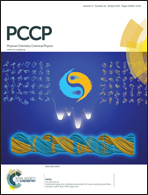Phase transitions in free water nanoparticles. Theoretical modeling of [H2O]48 and [H2O]118
Abstract
Classical parallel-tempering Monte Carlo simulations of [H2O]48 and [H2O]118 have been performed in the isothermal–isobaric ensemble and a two-dimensional multiple-histogram method has been used to calculate the heat capacity of the two clusters. A semiempirical procedure is proposed for the inclusion of quantum effects and transformed heat capacity profiles are compared with state-of-the-art experimental data [C. Hock et al., Phys. Rev. Lett., 2009, 103, 073401]. A very good agreement is achieved. A detailed analysis of the simulation data is provided to gain an insight into the nature of the phase change which takes place in the two clusters at T ≈ 100 K.
![Graphical abstract: Phase transitions in free water nanoparticles. Theoretical modeling of [H2O]48 and [H2O]118](/en/Image/Get?imageInfo.ImageType=GA&imageInfo.ImageIdentifier.ManuscriptID=C4CP04909H&imageInfo.ImageIdentifier.Year=2015)

 Please wait while we load your content...
Please wait while we load your content...